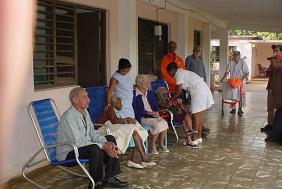
To grow old in Cuba
By R. H. Kravets
“A doctor and a nurse are on call here. The food given to the asylum is good and we have recreational projects, excursions and all that. But this hospice is basically a storage house for old people.”

My interlocutor answers my quizzical gesture.
“It matters little that they get robes, pajamas and a balanced diet when they’re robbed of their personality,” he says, alluding to the uncaring treatment usually given to elderly people.
My source explains that most of the staffers are not well trained and many are barely sensitive to the problems that beset old people.
“If the relatives have trouble dealing with their elders, you can imagine what it’s like to deal with someone else’s elders. And not just one but many.”
The biggest problem is found among the disabled or almost disabled, admitted to Cuba’s 127 homes for the elderly (an insufficient number), with room for 9,287 individuals who lack home care.
Some employees think they’re working in an assembly line and seat the little old women in a row, naked, to groom them. Have they ever thought that they, too, will someday reach that stage of helplessness?
Patients who live in the conjugal rooms or have sufficient mobility can do exercises and group games, participate in excursions (though few, they help), or socialize inside the building, but those whose motion is restricted are left at the mercy of employees who are not always magnanimous or kind.
Day patients (they’re brought in in the morning and taken home in the evening) fare better, because they don’t lose their links to their relatives.
A similar system of day care is maintained by the 230 Grandparents’ Homes throughout the island. They are centers devoted to the care of elderly people during working hours, which allows family members to keep their jobs. These places have a better system of affective care for old people. The best results have been found in Old Havana, in institutions sponsored by the City Historian.
Those sites for the day care of elderly people have room for 7,398 patients, a lot fewer than the 20,000 slots needed by the current population. For that reason, the Council of State arranged to renovate all facilities that require improvement and to build 13 more before 2015. In the same period, the State will create 140 more Grandparents’ Homes.
The dimensions of the problem, seen through statistics, are that Cuba has 2 million citizens over the age of 60 and that, by 2030, that number will rise to 3.4 million. The figures imply a notable reduction of the active labor force and a huge burden on the systems of social security and public health.
That is one reason why Parliament passed a law raising the retirement age (60 for women, 67 for men), just as developed nations have done.
Cuba’s demographic indicators show two major peaks of growth. Between 1959 and 1970, the nation’s population rose by 2 million, to 9 million inhabitants. Between 1970 and 2005, the population went from 9 million to 11,241,161 inhabitants, the current figure according to the 2012 census.
Eighteen percent of the current population is 60 years old or older, a figure that puts Cuba among the “more aged” Latin American countries.
The reasons are linked to an increase in life expectancy (78,97 years; 76 for men and 80 for women), to the low birth rate (1.5 children per woman) and to emigration. Not having sufficient replacement in the work force since 2010 complicates the current scenario and slows down the agenda set for the nation’s development.
Some strategies have been instituted to increase the birth rate. Infertile couples can go to municipal counseling centers and provincial centers for assisted reproduction. As a last resort, three other centers have advanced technology.
That does not seem sufficient and, instead, officials are considering regulating abortions, a procedure that many women view as a form of contraception.
Emigration is another channel for the loss of labor-capable population. It recently increased notably and, according to studies, will continue to increase until 2020, when it will drop.
Worth noting is the fact that, according to the National Office of Statistics and Information (ONEI), the cities with the lowest number of elderly people are Moa in Holguín province and Guantánamo in Guantánamo province (both at the eastern tip of the island) and the Isle of Youth. The three cities with the largest number of old people are Cabaiguán, Yaguajay and Sancti Spiritus, all in the center of the island.
Several institutions run by the Catholic Church have earned praise thanks to the virtuous activity of the devoted nuns who work there. The Santovenia Asylum in Havana ranks at the top, although smaller religious establishments deserve similar praise and are worthy of imitation.
Cuba’s health-care system has 279 specialists in geriatrics and gerontology (soon to rise to 416), not a big number, to be sure. The authorities plan to train the specialists and the technicians and service personnel who are in contact with the elderly, so they may have the tolerance and cordiality required for their jobs.
“With the government working on so many plans, I don’t see how it can give priority to the old people,” says, with lamentable and almost cynical certainty, a woman who works in an environment that, with some exceptions, remains adverse. I turn my back on her and her certainty, hoping that she’s totally wrong.
Progreso Semanal/ Weekly authorizes the total or partial reproduction of the articles by our journalists, so long as source and author are identified.


